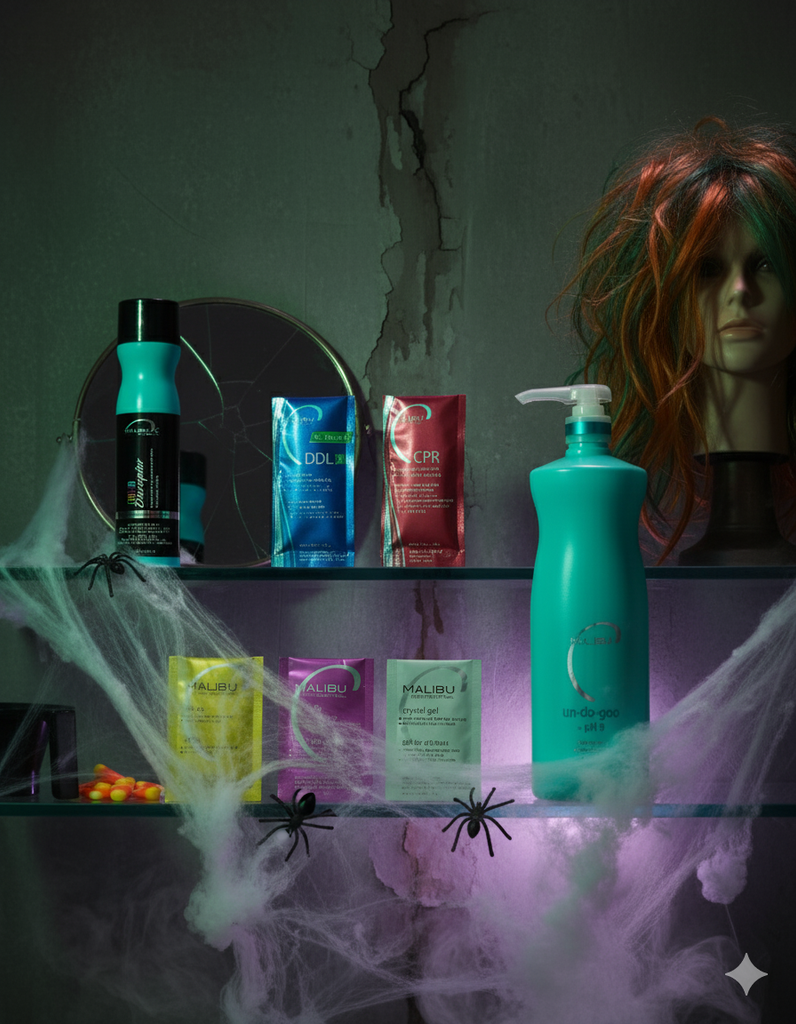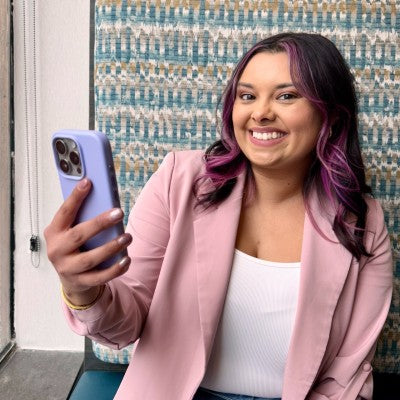Few things send a chill down a stylist’s spine quite like a client walking in with box-colored hair gone wrong.
Box colors promise quick, affordable, and transformative results, but behind the convenience lies a cocktail of challenges for both hair health and correction. Uneven tones, stubborn buildup, compromised integrity, and unpredictable undertones can all create what we call “scary hair.”
Luckily, with a little science (and the right Malibu C tools), there’s no reason to fear even the most haunting box dye cases.
The Fright Behind Box Color
Consumers often see box color as easy, affordable, and instant. However, as stylists know, those quick fixes often have long-term consequences.
“Box color uses heavy direct dyes that cling tightly to the hair fiber, making removal a real fright,” says Rina Dean, Malibu C’s cosmetic chemist.
To understand why, it’s important to break down how color deposition works. Demi-permanent and permanent dyes rely on oxidative chemistry. These dyes start as tiny, colorless molecules that can easily penetrate the hair cuticle and cortex. When mixed with developer (hydrogen peroxide), these molecules oxidize and expand, forming larger, colored molecules that become trapped inside the hair; hence, they’re not easily washed out.
While both box color and professional color use oxidative dyes, the difference lies in the formulation. Box colors are designed as one-size-fits-all solutions, meaning the formula is more aggressive and heavily buffered with a higher pH to ensure predictable results on resistant, unassessed hair. This higher alkalinity forces the cuticle open and allows deeper, more chaotic dye formation that’s difficult to reverse.
In contrast, professional color allows stylists to customize the developer strength, tone, and mixing ratio for each client. This precise control produces smaller, well-formed dye molecules that are easier to remove later and far less damaging to the hair’s structure.
The Science Behind the Scare
Box colors are built to “work on everyone,” which often means they over-deposit color, especially on porous or chemically processed hair.
“Hair with high porosity or prior damage has lifted and uneven cuticle scales,” explains Rina. “Coupled with the box color’s high pH formula, the dyes penetrate deeply and irregularly. This leads to patchy and stubborn staining.”
Previous chemical services, such as highlights, relaxers, or perms, can further increase the hair’s negative charge, which strengthens the ionic attraction between dye molecules and keratin. The result? Color that binds more tightly and resists removal compared to professional formulations crafted for individual hair conditions.
This is what makes box color corrections so complex, and why harsh, oxidative methods often cause more harm than help.
When Clients Come in with Scary Hair
If you’ve ever had a client sit down with uneven color bands, overly dark or brassy tones, or hair that feels coated and brittle, you’ve met “scary hair.”
The instinct may be to reach straight for bleach or an oxidative color remover, but Rina cautions against it.
“When you jump straight to bleach on box-dyed hair, the dense dye load interferes with peroxide’s ability to penetrate evenly,” she says. “That leads to unpredictable lift, patchy results, and potentially irreversible breakage.”
Essentially, the very dyes you’re trying to remove can act as barriers, preventing even lightening and creating additional stress on already-compromised hair.
Your Non-Damaging Rescue Plan: Malibu C to the Rescue
Thankfully, stylists have a safer, science-backed way to tackle box dye buildup: Malibu C’s Color Disruptor and CPR (Color Pigment Remover).
Color Disruptor helps loosen color molecules in artificial pigments before deeper corrective work begins. It’s ideal as a prep step before layering CPR on top of the hair or moving into a full correction process.
CPR (Color Pigment Remover) gently draws out unwanted oxidative color molecules without the use of harsh chemicals or damage.
“Malibu C’s antioxidant vitamin technology works by reducing and chelating trapped oxidative dye molecules without introducing additional oxidation or peroxides,” explains Rina. “Vitamin C acts as a reducing agent, breaking down large, oxidized dye molecules into smaller ones that can be safely removed. Meanwhile, Disodium EDTA binds residual minerals that stabilize those dyes, allowing for a clean, predictable removal.”
This non-oxidative approach prepares hair for a smoother color correction while preserving the hair’s integrity, shine, and manageability.
Turning Scary Hair into a Success Story
Box dye disasters don’t have to haunt your chair. Armed with the right knowledge and Malibu C’s professional-grade tools, stylists can confidently correct even the most intimidating cases, without damage or drama.
By leveraging science and gentle, antioxidant-based technology, you can deliver predictable, healthy results that restore trust and keep clients coming back.




